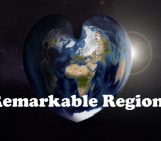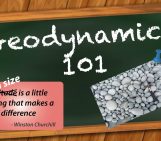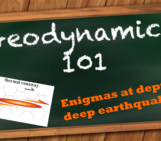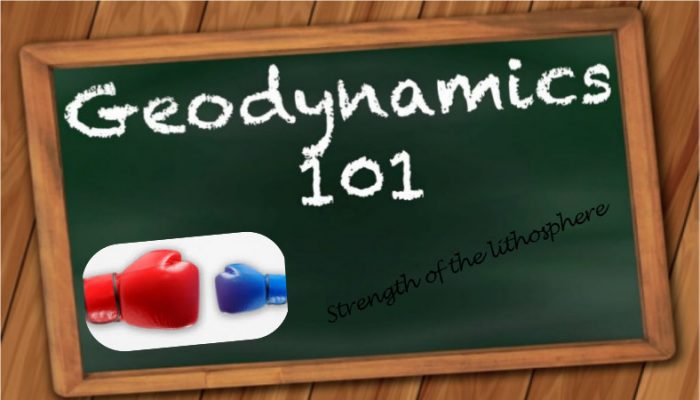
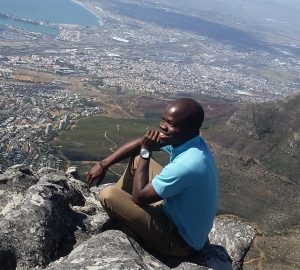 The Geodynamics 101 series serves to showcase the diversity of research topics and methods in the geodynamics community in an understandable manner. We welcome all researchers – PhD students to Professors – to introduce their area of expertise in a lighthearted, entertaining manner and touch upon some of the outstanding questions and problems related to their fields. For our latest ‘Geodynamics 101’ post, Postdoc Anthony Osei Tutu of GFZ Potsdam shares the outcomes of his PhD work, showing us that, like the lithosphere, it is OK to be weak sometimes!
The Geodynamics 101 series serves to showcase the diversity of research topics and methods in the geodynamics community in an understandable manner. We welcome all researchers – PhD students to Professors – to introduce their area of expertise in a lighthearted, entertaining manner and touch upon some of the outstanding questions and problems related to their fields. For our latest ‘Geodynamics 101’ post, Postdoc Anthony Osei Tutu of GFZ Potsdam shares the outcomes of his PhD work, showing us that, like the lithosphere, it is OK to be weak sometimes!
Strength is not everything in achieving one’s goal. The lithospheric plate acts both strong and weak at times. This dual characteristic of the outermost part of the Earth, the crustal-lithospheric shell, is thought to have sustained plate tectonics throughout Earth’s history, in the presence of other controlling mechanisms such as the weak asthenospheric layer (Bercovici et al. 2000; Karato 2012). In the world of the lithospheric plates there is the saying “I might be strong and unbreakable, but sometimes and somewhere, I am very weak, soft and brittle” and this allows the plates to accommodate each other in their relative movements.
We all sometimes need to bring out the soft part in us to accommodate others such as friends, family or colleagues. For example, my graduate school, the Helmholtz-Kolleg GEOSIM, an experiment by the Helmholtz Association, GFZ-Potsdam, University of Potsdam and Free University of Berlin, brought together two or more experts in mathematics and geosciences to collaborate on and serve as PhD supervisors for answering some of Earth Sciences’ pressing questions. The many, many benefits of this multidisciplinary PhD supervising approach also came with challenges. Sometimes, the different supervisors would make opposing/contrasting suggestions to investigate a particular problem according to the experience of some students and myself. Then it falls on you as the student to stand firm (i.e. be strong) on what you believe works for your experiments and at the same time to be receptive (i.e. flexible or soft) to the different suggestions, while keeping in mind the limited time you have as a PhD student.

Figure 1: Schematic plot of the conditions in a subduction system (left) aiding or (right) hindering global plate motions.
The both strong and weak behavior of the lithospheric plates was one of the conclusions of my PhD study. Besides the strong plate interiors (Zhong and Watts 2013), weak regions along the plate boundaries, aided by sediment and water (see Fig. 1), are required to give the low friction between the subducting and overriding plates (Moresi and Solomatov 1998; Sobolev and Babeyko 2005), combined with a less viscous sublithospheric mantle. This combination was key to match the magnitude and direction of present-day global plate motions in the numerical modeling study (Osei Tutu et al. 2018). I used the global 3D lithosphere-asthenosphere numerical code SLIM3D (Popov and Sobolev 2008) with visco-elasto-plastic rheology coupled to a mantle flow code (Hager and O’Connell 1981) for the investigation. To understand the influence of intra-plate friction (brittle/plastic yielding) and asthenospheric viscosity on present-day plate motions, I tested a range of strengths of the plate boundary. Past numerical modeling studies (Moresi and Solomatov 1998; Crameri and Tackley 2015) have suggested that small friction coefficients (μ < 0.1, yield stress ~100 MPa) can lead to plate tectonics in models of mantle convection. This study shows that in order to match present-day plate motions and net rotation, the static frictional parameter must be less than 0.05 (15 MPa yield stress). I am able to obtain a good fit with the magnitude and orientation of observed plate velocities (NUVEL-1A) in a no-net-rotation reference frame with μ < 0.04 and a minimum asthenosphere viscosity of 5•1019 Pas to 1•1020 Pas (Fig. 2). The estimates of net-rotation (NR) of the lithosphere suggest that amplitudes of ~0.1– 0.2 °/My, similar to most observation-based estimates, can be obtained with asthenosphere viscosity cutoff values of ~1•1019 Pas to 5•1019 Pas and a friction coefficient μ < 0.05.
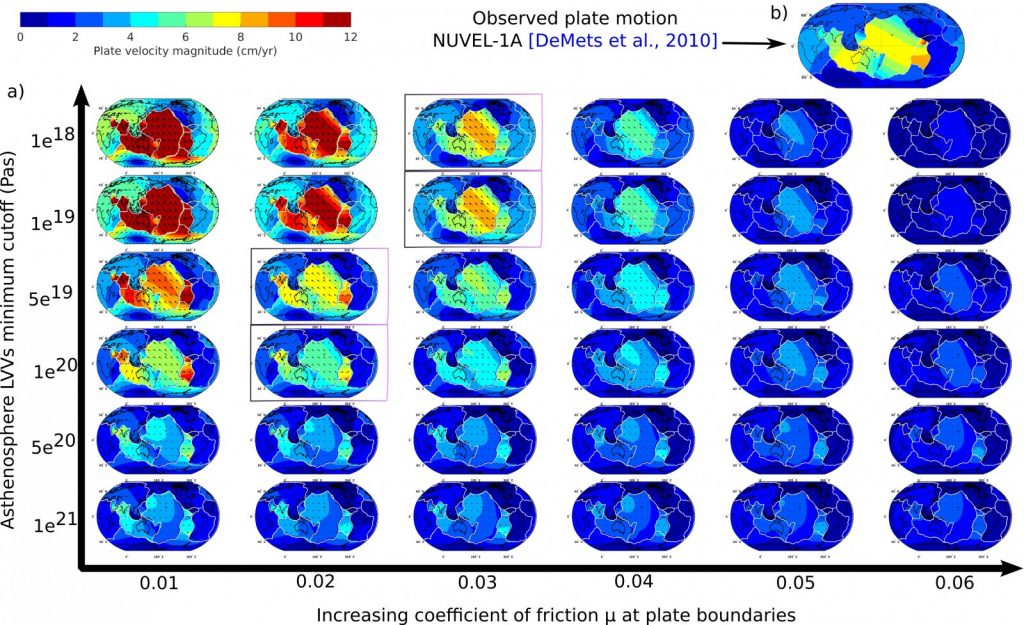
Figure 2: Set of predicted global plate motions for varying asthenosphere viscosity and plate boundary frictions, modified after Osei Tutu et al. (2018). Rectangular boxes show calculations with RMS velocities comparable to the observed RMS velocity of NUVEL-1A (DeMets et al. 2010).
The second part of my PhD study focused on the responses of the strong plate interiors to the convecting mantle below by evaluating the influence of shallow and deep mantle heterogeneities on the lithospheric stress field and topography. I explored the sensitivity of the considered surface observables to model parameters providing insights into the influence of the asthenosphere and plate boundary rheology on plate motion by testing various thermal-density structures to predict stresses and topography. Lithospheric stresses and dynamic topography were computed using the model setup and rheological parameters that gave the best fit to the observed plate motions (see rectangular boxes in Fig. 2). The modeled lithosphere stress field was compared the World Stress Map 2016 (Heidbach et al. 2016) and the modeled dynamic topography to models of observed residual topography (Hoggard et al. 2016; Steinberger 2016). I tested a number of upper mantle thermal-density structures. The thermal structure used to calculate the plate motions before is considered the reference thermal-density structure, see also Osei Tutu et al. (2017). This reference thermal-density structure is derived from a heat flow model combined with a sea floor age model. In addition I used three different thermal-density structures derived from global S-wave velocity models to show the influence of lateral density heterogeneities in the upper 300 km on model predictions. These different structures showed that a large portion of the total dynamic force generating stresses in the crust/lithosphere has its origin in the deep mantle, while topography is largely influenced by shallow heterogeneities. For example, there is hardly any difference between the stress orientation patterns predicted with and without consideration of the heterogeneities in the upper mantle density structure across North America, Australia and North Africa. However, inclusion of crustal thickness variations in the stress field simulations (as shown in Fig. 3a) resulted in crustal dominance in areas of high altitude in terms of stress orientation, for example in the Andes and Tibet, compared to the only-deep mantle contributions (as shown in Fig. 3b).
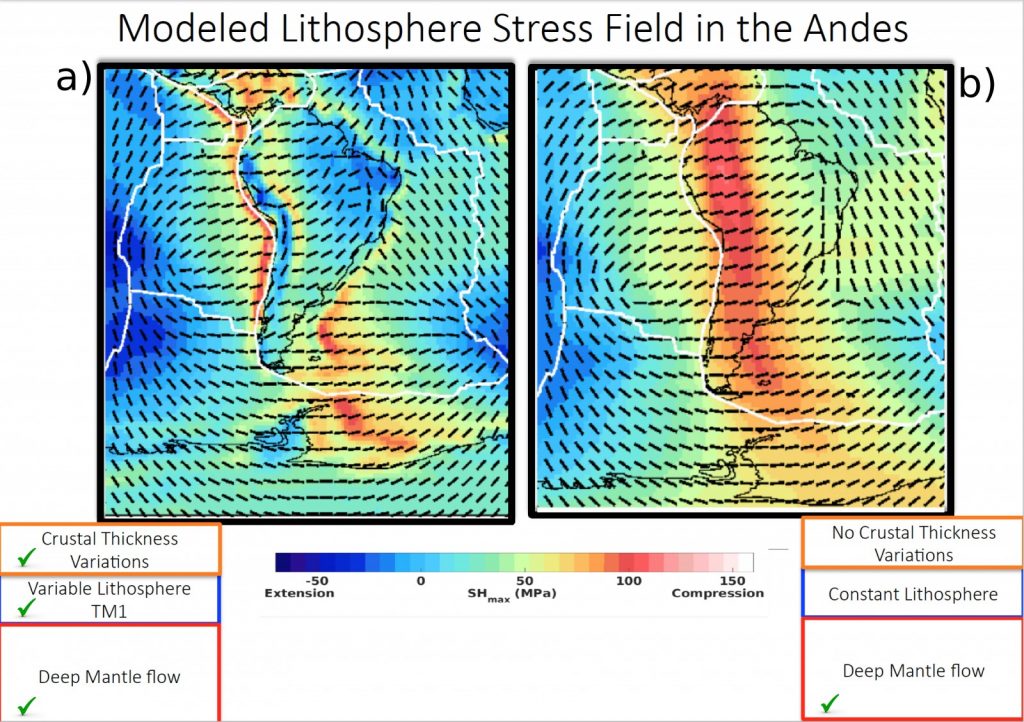
Figure 3: Modeled lithosphere stress field in the Andes considering (a) crustal thickness variations from the CRUST 1.0 model as well as lithospheric variations and (b) uniform crustal and lithospheric thicknesses.
The outer shell of the solid Earth is complex, exhibiting different behaviors on different scales. In our quest to understand its dynamics, we can learn from the lithospheric plate’s life cycle how to live our lives and preserve our existence as scientist-humans by accommodating one another. After all, they have existed for billions of years.
References: Bercovici, David, Yanick Ricard, and Mark A. Richards. 2000. “The Relation Between Mantle Dynamics and Plate Tectonics: A Primer.” 5–46. Crameri, Fabio and Paul J. Tackley. 2015. “Parameters Controlling Dynamically Self-Consistent Plate Tectonics and Single-Sided Subduction in Global Models of Mantle Convection.” Journal of Geophysical Research: Solid Earth 120(5):3680–3706, 10.1002/2014JB011664. DeMets, Charles, Richard G. Gordon, and Donald F. Argus. 2010. “Geologically Current Plate Motions.” Geophys. J. Int 181:1–80. Hager, BH and RJ O’Connell. 1981. “A Simple Global Model of Plate Dynamics and Mantle Convection.” Journal of Geophysical Research: Solid Earth, 86(B6):4843–4867, 10.1029/JB086iB06p04843. Heidbach, Oliver, Mojtaba Rajabi, Moritz Ziegler, Karsten Reiter, and Wsm Team. 2016. “The World Stress Map Database Release 2016 -Global Crustal Stress Pattern vs. Absolute Plate Motion.” Geophysical Research Abstracts EGU General Assembly 18:2016–4861. Hoggard, M. J., N. White, and D. Al-Attar. 2016. “Global Dynamic Topography Observations Reveal Limited Influence of Large-Scale Mantle Flow.” Nature Geoscience 9(6):456–63, 10.1038/ngeo2709. Karato, Shun-Ichiro. 2012. “On the Origin of the Asthenosphere.” Earth and Planetary Science Letters 321–322:95–103. Moresi, Louis and Viatcheslav Solomatov. 1998. “Mantle Convection with a Brittle Lithosphere: Thoughts on the Global Tectonic Styles of the Earth and Venus.” Geophysical Journal International 133(3):669–82, 10.1046/j.1365-246X.1998.00521.x. Osei Tutu, A., S. V Sobolev, B. Steinberger, A. A. Popov, and I. Rogozhina. 2018. “Evaluating the Influence of Plate Boundary Friction and Mantle Viscosity on Plate Velocities.” Geochemistry, Geophysics, Geosystems n/a-n/a, 10.1002/2017GC007112. Popov, A. A. and S. V. Sobolev. 2008. “SLIM3D: A Tool for Three-Dimensional Thermomechanical Modeling of Lithospheric Deformation with Elasto-Visco-Plastic Rheology.” Physics of the Earth and Planetary Interiors 171(1–4):55–75. Sobolev, S. V. and A. Y. Babeyko. 2005. “What Drives Orogeny in the Andes?” Geology 33(8). Steinberger, Bernhard. 2016. “Topography Caused by Mantle Density Variations: Observation-Based Estimates and Models Derived from Tomography and Lithosphere Thickness.” Geophysical Journal International 205(1):604–21, 10.1093/gji/ggw040. Osei Tutu, A., B. Steinberger, S. V Sobolev, I. Rogozhina, and A. Popov. 2017. "Effects of Upper Mantle Heterogeneities on Lithospheric Stress Field and Dynamic Topography." Solid Earth Discuss., https://doi.org/10.5194/se-2017-111, in review, 2017 Zhong, Shijie and A. B. Watts. 2013. “Lithospheric Deformation Induced by Loading of the Hawaiian Islands and Its Implications for Mantle Rheology.” Journal of Geophysical Research: Solid Earth 118(11):6025–48, 10.1002/2013JB010408.

